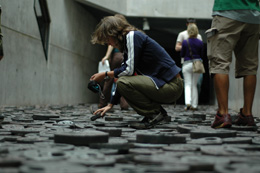
Getting to the Jewish Museum was not an easy task despite the apparent simplicity of the process – get on the M1, then switch to U6, and then walk for ten minutes. But what happens if it starts raining? You take out an umbrella, of course. Or you put on the raincoat you cautiously brought with you. Or you could just sit under the sheltering glass of the Oranienburgerstrasse tram stop wondering if a flood of biblical dimensions is about to occur. Yes, it rained that heavily. After much hesitation and debate a brave decision was made and students sprinted through the mighty drops to reach the metro. Ten seconds were sufficient to soak up the majority of them.
A mini-adventure preceded a proper one which consisted of making your way through the mazy, narrow corridors of the museum, an original and thought-provoking architectural construct. Most buildings of this kind are designed simply to house various works of art; the Jewish Museum is itself a work of modern art, a thunderbolt-shaped metallic structure that is both spectacular and depressing. To begin your visit you must first go underground and then climb the stairs that lead to the permanent exhibition – perhaps a metaphor for human struggle and oppression: one must fall into the abyss of despair and then rise above pain and suffering.
The underground section consists of three axes. Firstly, the Axis of Exile is marked by the Garden of Exile, a place that bares a striking resemblance to the fairly recent “Memorial to the Murdered Jews of Europe”. Then, the Axis of Death culminates in the impressive Holocaust Tower. Last but not least, the Axis of Continuity hosts a wide range of personal belongings (from a sewing machine to soap, from postcards to toys) that tell the tragic or life-affirming stories of their owners. However, what truly strikes a chord is the Holocaust Tower, a 5-sided empty room with a single neon and a ladder that cannot be reached. As you sit in one of the corners and look at others gently leaning their heads against the wall, you realize the impact this room can have on people.
Once the visit to the lower part has been completed, there is no further way to go but up. The Memory Void is the final stop before the permanent exhibition. Yet this void has been filled with an installation by Menashe Kadishman called “Fallen Leaves”. As you walk on the “leaves”, which are actually representations of agonizing human faces of all ages, a sickening sound starts to develop. We all walk differently – some cautiously and painfully, others decidedly, and some even barefoot, but the blend of our manners creates an atmosphere of terror and destruction under the scrutinizing eyes of visitors looking from small windows placed at a considerable height. It is in such moments of metallic rustling and deep meditation that you realize that there are times in history when people should refrain from walking, especially from trampling the lives of others.
To recover from the effect of Kadishman’s installation is a time consuming effort. Once you start making your way through over two millennia of German Jewish history, you inevitably meet other students and exchange opinions about the Memory Void. But then, you carry on through an incredibly rich, highly interactive account of the Jewish accomplishments: successful merchants and businesspeople, religious innovators, resolute working mothers, well known artists, writers and philosophers. From Moses Mendelssohn, who has been dubbed the “German Socrates” to Levis Strauss and his now famous jeans, from the traditions of a Jewish wedding to the homework of gifted youngsters – the portrayal is extremely positive.
But that is not the essential inquiry here. What really matters is what you take with you once you have stepped out of the museum. The only words that come close to accurately describing the main feelings are raised awareness, a broader understanding and many, many mysteries to ponder upon. One of most important ones is if it does truly does justice to the Jewish culture: this answer is not in our possession.
By Catalina Iorga (ISU ’07, Romania)
